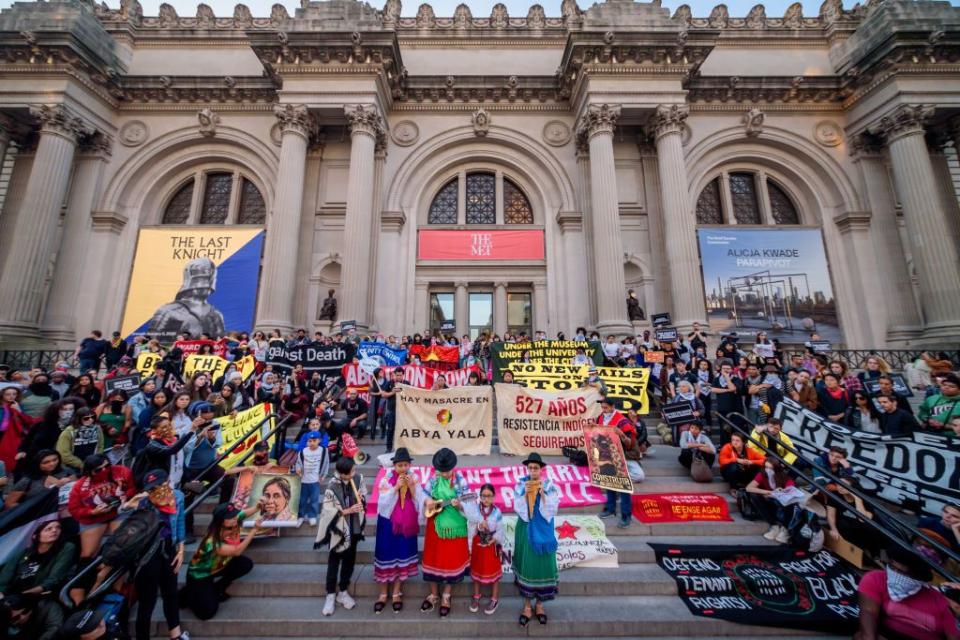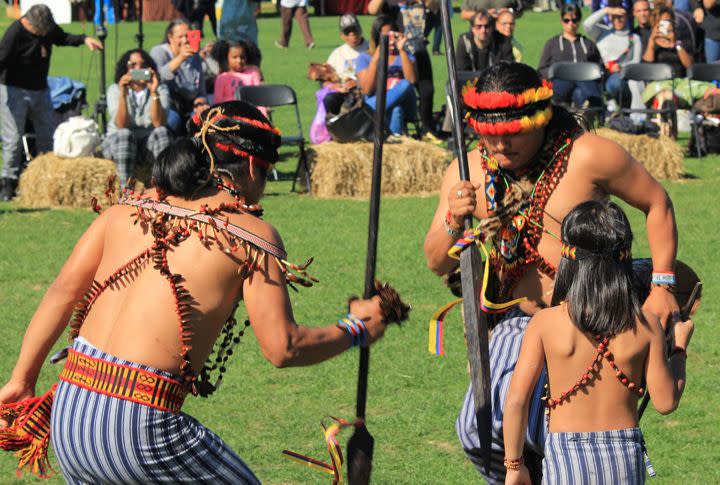How You Can Acknowledge Indigenous Peoples' Day This Year

“Hearst Magazines and Verizon Media may earn commission or revenue on some items through the links below.”
First proposed in 1977, Indigenous Peoples’ Day has grown rapidly in the last few years. More and more cities recognize the importance of a day that celebrates Native American cultures, while acknowledging their resilience in the face of a long history of abuse and marginalization. But for Indigenous people, the holiday, which takes place the second Monday in October—it falls on October 11 in 2021—simply acknowledges a battle they have always faced.
“Every day is Indigenous Peoples Day. That’s how we look at it,” Shannon O’Loughlin, executive director for the Association on American Indian Affairs (AAIA), tells Oprah Daily. “Every day we are fighting to protect sovereignty and preserve culture.”
That year-round mission is recognized on Indigenous Peoples’ Day, which currently shares a date with Columbus Day, the celebration of Italian-born explorer Christopher Columbus voyaging from Spain to the Americas in 1492. For some Italian-Americans, Columbus Day became synonymous with their heritage. Though Columbus Day has been a federal holiday since 1937, it's increasingly being replaced by Indigenous Peoples' Day; Oregon became the latest state to recognize it in May 2021.
As the United States reckons with the racism and marginalization that are undeniable parts of its history, it’s important to speak about the harm faced by Native people at the hands of colonizers. To name a few examples, they were ravaged by diseases brought over by European explorers and settlers, forced from their tribal land as the United States expanded, and more recently, sterilized in large numbers.
Still, there is pushback, particularly from some members of the Italian-American community, arguing that ending Columbus Day would be diminishing their struggle with persecution around the time of World War II. Italian Heritage Month falls in October due to Columbus Day, and many Italian-Americans see it as a broader recognition of their history. In New Haven, CT, Columbus Day has been renamed "Italian Heritage Day."
With 574 tribes recognized by the U.S. government, and another 300-plus sovereign tribal nations, there's no one way to observe Indigenous Peoples’ Day is acknowledged. But organizations like the AAIA and Redhawk Native American Arts Council recognize it as one where those who aren't Native American can be educated, culture can be shared, and historical misconceptions can be combated.
Here's what to know about Indigenous Peoples' Day, and how to observe it respectfully if you're not of Indigenous heritage.
Indigenous Peoples’ Day was first observed in South Dakota, but has spread in recent years.
Though it was initially proposed at a U.N. conference in 1977, the first state to actually hold a form of Indigenous Peoples’ Day (called Native American Day) was South Dakota in 1989. At the time, the state’s governor, George Mickelson, was trying to spur a “Year of Reconciliation” between the native population and the white population, which had animosity towards each other.
The holiday began to spread along the West Coast and Midwest until 2015, when places all around the country began officially recognizing it. Some states, like California and Tennessee, also have a Native American Day that is celebrated in late September.
Indigenous Peoples’ Day is also an important day in schools, where it can be a lens to explain the realities of colonialism for Native American. It’s also a time to challenge commonly-held ideas about western history, particularly those related to Christopher Columbus.
Its opposition to Columbus Day has caused controversy.
For America’s Indigenous population, Christopher Columbus's voyage and the subsequent spread of colonization is not something to be celebrated: His 1492 arrival began centuries of enslavement, abuse, and forced assimilation. That's why, for many, it’s important that Indigenous Peoples’ Day sits in direct opposition to the holiday celebrating the first people who tried to lay claim to the already-occupied land that's now called America.
“The holiday is in protest, in a way, of Columbus Day. It’s saying, despite Columbus, despite colonization, despite the attempted genocide of an entire hemisphere of people, we are still here,” Redhawk Cultural Director Cliff Matias, who is Quechua and Taíno, tells Oprah Daily.

Some Italian-Americans have fought to keep Columbus Day, arguing that it commemorates the struggles of Italian immigrants when they arrived here in the late 19th and early 20th centuries. It is also the only major holiday acknowledging an Italian person.
Native voices are sympathetic to the importance of acknowledging a group’s struggles, but not in a way that misrepresents history and lionizes a figure like Columbus, who to them is synonymous with harm.
“This is not about erasing history, it’s about truth telling. We should also be celebrating Italian-Americans, but we should be truthful about history,” says O’Loughlin.
Many states recognize Indigenous Peoples' Day.
States including Louisiana, Wisconsin, and Oregon observe Indigenous Peoples’ Day in lieu of Columbus Day. Others have renamed the day something like Discoverers’ Day, as Hawaii opted to. Berkeley, California, was the first city to outright replace Columbus Day, doing so in 1994. And in September 2020, Arizona Governor Doug Ducey announced that his state would recognize Indigenous Peoples’ Day that year, with State Sen. Jamescita Peshlakai vowing to introduce a bill to make it permanent.
While much attention is put on Indigenous Peoples’ Day in October, there is more time to celebrate in November, which is Native American Heritage Month.
There aren’t necessarily specific traditions associated with Indigenous Peoples’ Day.
In 2021, some events that were canceled in 2020 due to the COVID-19 pandemic are back on again. Large group events are set to take place in cities including New York and Philadelphia, though others are taking a wait-and-see approach while virus cases rise due to the Delta variant.
In New York, Randall’s Island is frequently the site of Indigenous Peoples’ Day celebrations, which feature music, storytelling, dance, land acknowledgments, and food. A two-day event is scheduled for October 10-October 11 in 2021.
In cities like Boulder, there are traditionally parades for the holiday, as well as sunrise ceremonies, food tastings, and film festivals. These events are generally open to the public, though non-Native Americans should keep in mind that they are guests in these spaces.

Matias clarifies that because of the native population's struggles with COVID-19 and the lack of governmental support they've received, many tribes are being extremely cautious about group gatherings.
For those not yet comfortable with mass celebrations—and in places where events are still canceled due to the virus—online options include participating in the Social Distance Powwow, which has more than 250,000 Facebook members and was cited by both O’Loughlin and Matias. Or, check out the online version of the popular Santa Fe Indian Market.
Something more individual and tactile that one can do is consider the physical space they occupy, which Native Americans do through land acknowledgments. O’Loughlin explains that tribes often felt indebted to the Earth around them, and sought to safeguard it. Now, land acknowledgment statements are increasingly made to honor the Indigenous people who occupied that space, and reflect on the widespread displacement of Native Americans.
“We recognize the people who stood here and protected this land and protected the Earth before us...I think there’s a responsibility to everyone in the United States to understand what land you’re standing on and to learn about the history of the place that you occupy, to respect the ground that you walk on,” she says.
Shifting your perspective in this way is a first step in being an ally to the landback movement, a longtime, multi-pronged effort in the United States and Canada to reclaim Indigenous land and culture. Those efforts include advocacy aiming to literally reclaim land forcibly taken by colonizers, and organized protests such as those in the Black Hills of South Dakota during then-President Trump's visit to Mount Rushmore. For others in the movement, it can mean educating people within and outside of Native communities about long-forgotten traditions, and reviving them.
It's a perfect opportunity to support Native American communities and art.
Cultural preservation is essential to Native Americans, but sometimes the outside emphasis on earlier centuries can also diminish their present day creative accomplishments. O’Loughlin explains that is affected by the education system’s framing of Indigenous people as only past history.
“Partly the reason for that is when you go to public school and learn about American Indians, that education stops around 1900,” she says. “The general population doesn’t learn anything beyond 1920, so they see us as a historic, vintage picture of someone wearing a headdress. They don’t know who we are today.”
Here are some ways to educate yourself and support Native American communities:
Support Redhawk, who is committed to helping represent and support practitioners of traditional art forms. They also offer courses in these disciplines to keep them alive. They work to expand the notion of native art to encompass and celebrate modern work, too. “It seems that America has finally allowed Indigenous people to move into the 21st century,” says Matias.
Buy and stream music from artists of Native descent. Matias and O’Loughlin were both quick to offer suggestions of artists to check out, including genre-bending rapper Princess Nokia, Academy Award-winner Buffy Sainte-Marie, as well as groups like Peace Poets and A Tribe Called Red.
Read work created by those who identify as Indigenous, such as best-selling writer Tommy Orange, author of National Book Critics Circle Award winner There There, and Poet Laureate Joy Harjo, the first Native American with that title. Check out our list of 31 Native American writers, too.
Read—and share!—the Indigenous Peoples Day Toolkit from nonprofit IllumiNative, a comprehensive resource that also includes advice on subjects such as, "how to respond to opposition against Indigenous Peoples Day."
If you're interested in supporting the landback movement, follow and/or donate to Indigenous organizers NDN Collective.
If you have the means, consider donating to the Native Voter Fund to aid registration efforts, outreach, and protection against voter suppression.
Beyond exploring native culture independently, teachers and others can look to partner with a Native American organization as an educational resource, but should be aware that these groups are often inundated with requests around the holiday, says O’Loughlin.
She stresses that organizations like hers are always happy to share information and culture, but that people should also do their own research about Native American life so that they can both be better allies and appreciate the vast history and promising future of the Indigenous population.
You Might Also Like

